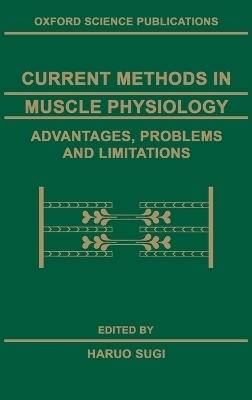
Current Methods in Muscle Physiology
Advantages, Problems and Limitations
Seiten
1998
Oxford University Press (Verlag)
978-0-19-852397-0 (ISBN)
Oxford University Press (Verlag)
978-0-19-852397-0 (ISBN)
Aims to describe critically various experimental methods currently used in the field of muscle research. For each method discussed, there is a comprehensive description of its advantages, problems, and limitations and each chapter contains a summary of the central results to have been obtained using each method.
Despite extensive physiological, biochemical, and structural studies, the mechanisms of muscle contraction operating in living muscle fibres are still not clearly understood. This book aims to describe and assess various experimental methods currently used in the field of muscle research. For each method discussed, there is a comprehensive description of its advantages, problems, and limitations. Each chapter also contains a summary of the central results to have been obtained using each method. Comprehensively written by experts in their respective fields, this book will be of interest to all investigators in muscle physiology.
Despite extensive physiological, biochemical, and structural studies, the mechanisms of muscle contraction operating in living muscle fibres are still not clearly understood. This book aims to describe and assess various experimental methods currently used in the field of muscle research. For each method discussed, there is a comprehensive description of its advantages, problems, and limitations. Each chapter also contains a summary of the central results to have been obtained using each method. Comprehensively written by experts in their respective fields, this book will be of interest to all investigators in muscle physiology.
Chapter 1 - Combined biochemical and mechanical experiments ; Muscle mechanics I - intact single muscle fibres ; Muscle mechanics II - skinned muscle fibres ; The use of caged compounds ; The use of fluorescent nucleotides ; The use of peptide mimetics ; The use of recombinant molecules ; In vitro motility assay ; Chapter 2 - Combined structural and mechanical experiments ; The use of fluorescent probes ; The use of spin probes ; Time resolved X-ray diffraction ; Electron microscopy coupled with quick freezing ; Chapter 3 - The use of Ca2+ indicators ; Chapter 4 - Electrophysiological techniques ; Chapter 5 - Techniques for muscle energetics
| Erscheint lt. Verlag | 22.1.1998 |
|---|---|
| Zusatzinfo | halftones, line figures, tables |
| Verlagsort | Oxford |
| Sprache | englisch |
| Maße | 161 x 242 mm |
| Gewicht | 787 g |
| Themenwelt | Studium ► 1. Studienabschnitt (Vorklinik) ► Anatomie / Neuroanatomie |
| Studium ► 1. Studienabschnitt (Vorklinik) ► Physiologie | |
| Naturwissenschaften ► Biologie ► Biochemie | |
| Naturwissenschaften ► Biologie ► Humanbiologie | |
| ISBN-10 | 0-19-852397-1 / 0198523971 |
| ISBN-13 | 978-0-19-852397-0 / 9780198523970 |
| Zustand | Neuware |
| Haben Sie eine Frage zum Produkt? |
Mehr entdecken
aus dem Bereich
aus dem Bereich
Buch | Hardcover (2022)
Urban & Fischer in Elsevier (Verlag)
CHF 307,95
Struktur und Funktion
Buch | Softcover (2021)
Urban & Fischer in Elsevier (Verlag)
CHF 61,60
+ Web + Lehrbuch
Buch | Hardcover (2022)
Urban & Fischer in Elsevier (Verlag)
CHF 348,55


